Governance Case Study: The Corporate Collapse of Dick Smith Retail
VerifiedAdded on 2023/01/18
|14
|3903
|27
Case Study
AI Summary
This case study examines the corporate collapse of Dick Smith Retail, an Australian electronics retailer. It delves into the reasons behind the company's downfall, including poor strategies, leadership failures, and inventory management issues. The analysis explores the roles of directors and executives, identifying legal, ethical, and governance issues arising from the collapse. The study assesses the impact on stakeholders, including investors, employees, and suppliers. It also provides recommendations on how such situations could have been avoided, emphasizing the importance of proper planning, ethical conduct, and adherence to corporate governance principles. The report highlights the misrepresentation of financial data and the unethical practices that contributed to the company's failure. It serves as a comprehensive analysis of the events leading to the collapse and its implications.
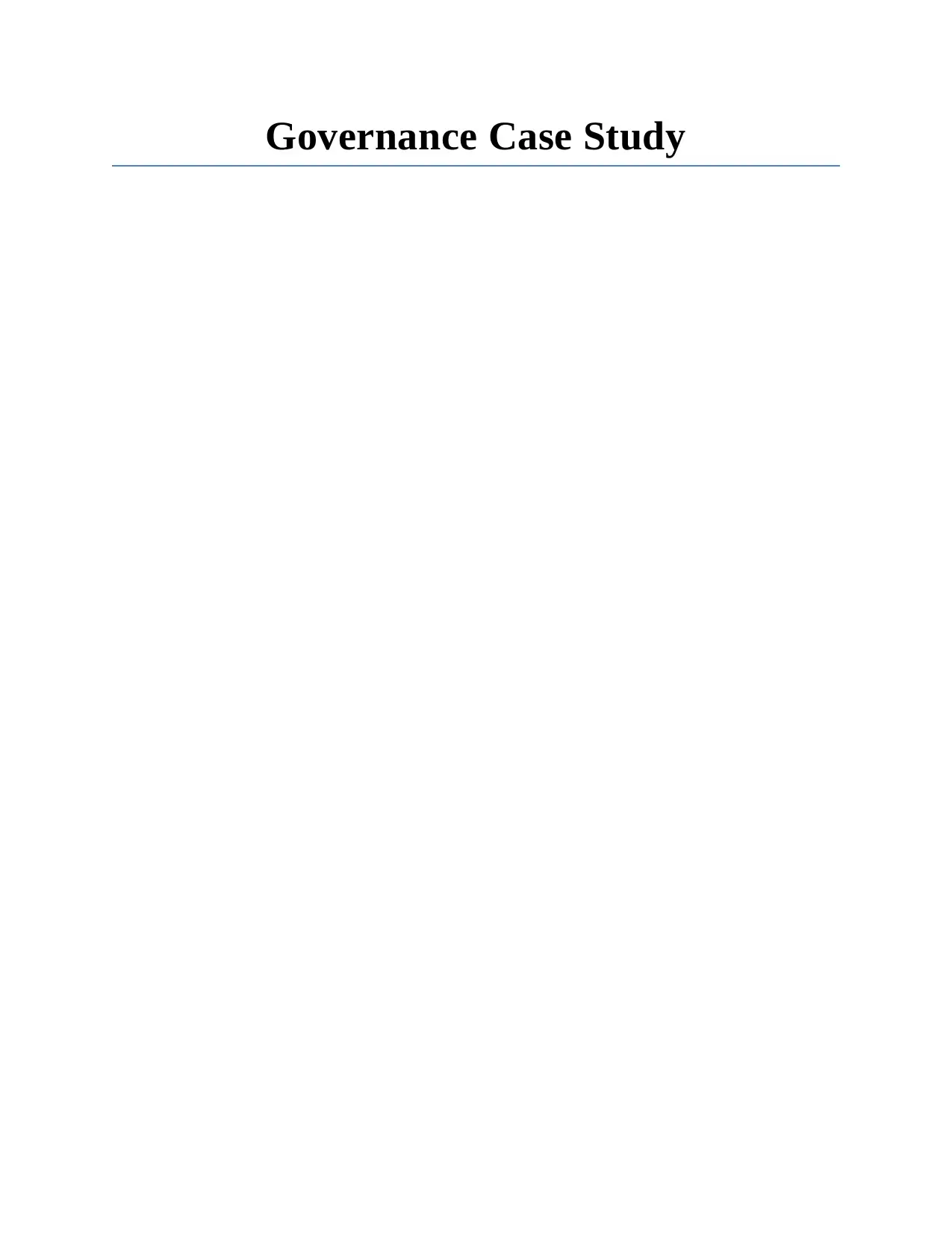
Governance Case Study
Paraphrase This Document
Need a fresh take? Get an instant paraphrase of this document with our AI Paraphraser
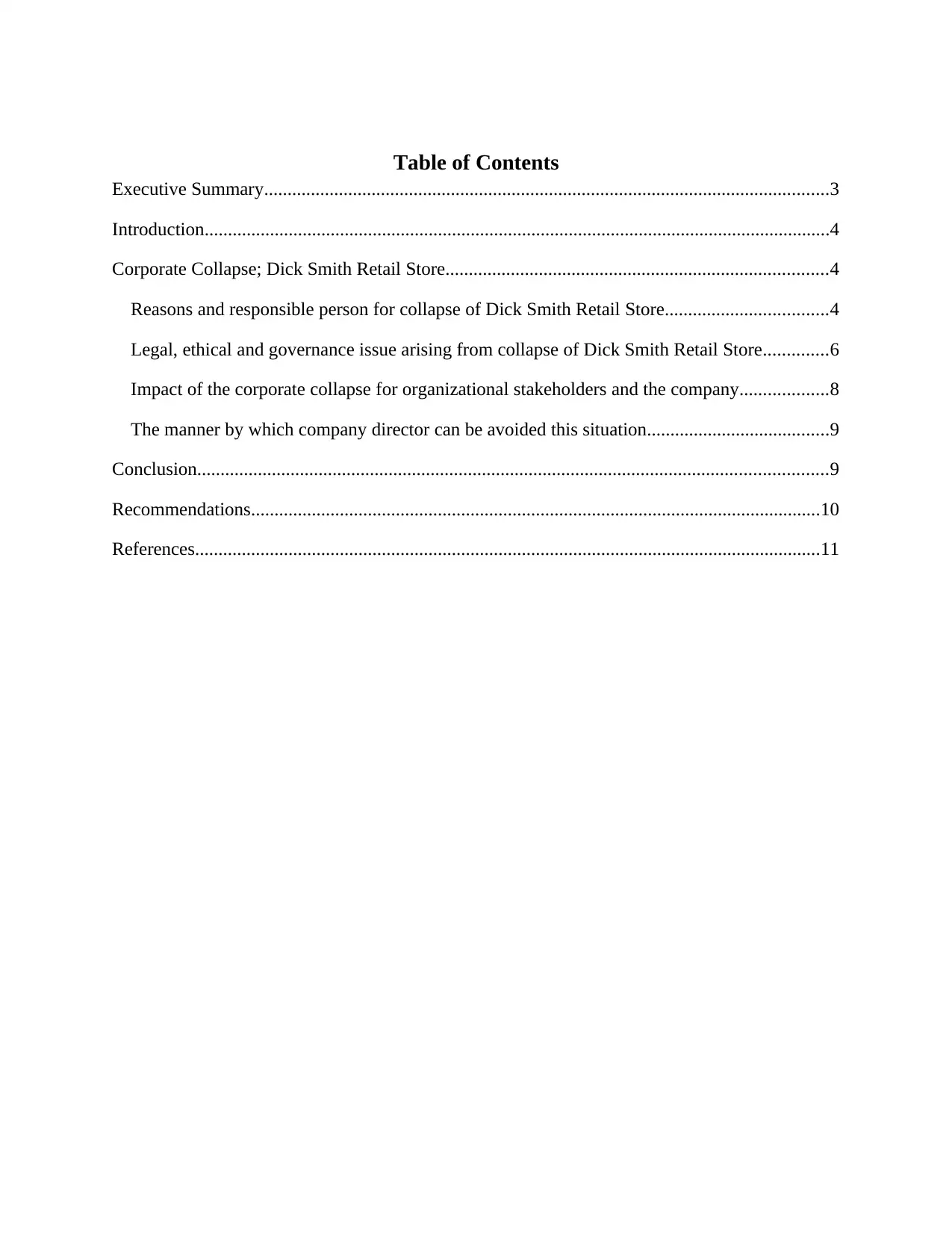
Table of Contents
Executive Summary.........................................................................................................................3
Introduction......................................................................................................................................4
Corporate Collapse; Dick Smith Retail Store..................................................................................4
Reasons and responsible person for collapse of Dick Smith Retail Store...................................4
Legal, ethical and governance issue arising from collapse of Dick Smith Retail Store..............6
Impact of the corporate collapse for organizational stakeholders and the company...................8
The manner by which company director can be avoided this situation.......................................9
Conclusion.......................................................................................................................................9
Recommendations..........................................................................................................................10
References......................................................................................................................................11
Executive Summary.........................................................................................................................3
Introduction......................................................................................................................................4
Corporate Collapse; Dick Smith Retail Store..................................................................................4
Reasons and responsible person for collapse of Dick Smith Retail Store...................................4
Legal, ethical and governance issue arising from collapse of Dick Smith Retail Store..............6
Impact of the corporate collapse for organizational stakeholders and the company...................8
The manner by which company director can be avoided this situation.......................................9
Conclusion.......................................................................................................................................9
Recommendations..........................................................................................................................10
References......................................................................................................................................11
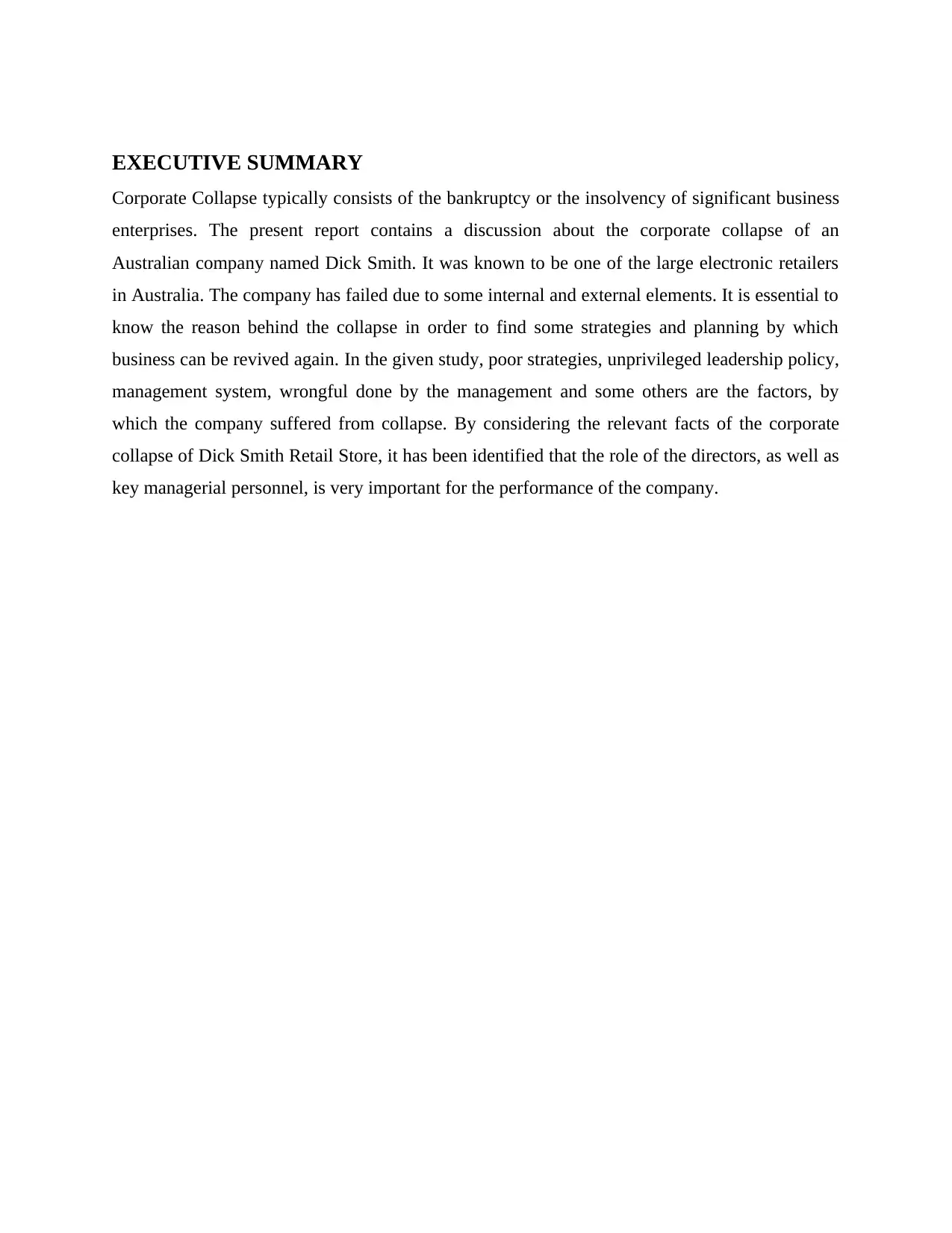
EXECUTIVE SUMMARY
Corporate Collapse typically consists of the bankruptcy or the insolvency of significant business
enterprises. The present report contains a discussion about the corporate collapse of an
Australian company named Dick Smith. It was known to be one of the large electronic retailers
in Australia. The company has failed due to some internal and external elements. It is essential to
know the reason behind the collapse in order to find some strategies and planning by which
business can be revived again. In the given study, poor strategies, unprivileged leadership policy,
management system, wrongful done by the management and some others are the factors, by
which the company suffered from collapse. By considering the relevant facts of the corporate
collapse of Dick Smith Retail Store, it has been identified that the role of the directors, as well as
key managerial personnel, is very important for the performance of the company.
Corporate Collapse typically consists of the bankruptcy or the insolvency of significant business
enterprises. The present report contains a discussion about the corporate collapse of an
Australian company named Dick Smith. It was known to be one of the large electronic retailers
in Australia. The company has failed due to some internal and external elements. It is essential to
know the reason behind the collapse in order to find some strategies and planning by which
business can be revived again. In the given study, poor strategies, unprivileged leadership policy,
management system, wrongful done by the management and some others are the factors, by
which the company suffered from collapse. By considering the relevant facts of the corporate
collapse of Dick Smith Retail Store, it has been identified that the role of the directors, as well as
key managerial personnel, is very important for the performance of the company.
⊘ This is a preview!⊘
Do you want full access?
Subscribe today to unlock all pages.

Trusted by 1+ million students worldwide
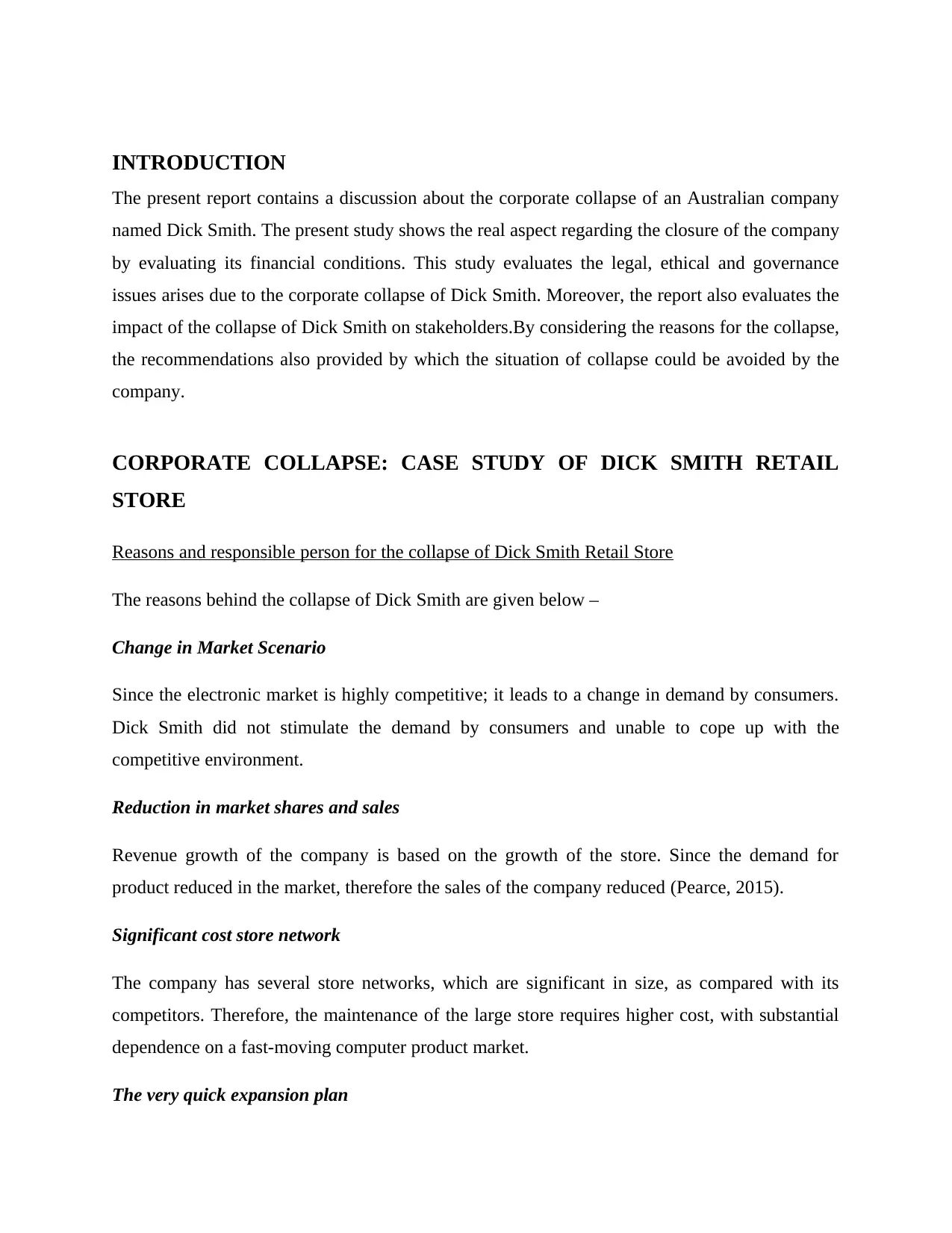
INTRODUCTION
The present report contains a discussion about the corporate collapse of an Australian company
named Dick Smith. The present study shows the real aspect regarding the closure of the company
by evaluating its financial conditions. This study evaluates the legal, ethical and governance
issues arises due to the corporate collapse of Dick Smith. Moreover, the report also evaluates the
impact of the collapse of Dick Smith on stakeholders.By considering the reasons for the collapse,
the recommendations also provided by which the situation of collapse could be avoided by the
company.
CORPORATE COLLAPSE: CASE STUDY OF DICK SMITH RETAIL
STORE
Reasons and responsible person for the collapse of Dick Smith Retail Store
The reasons behind the collapse of Dick Smith are given below –
Change in Market Scenario
Since the electronic market is highly competitive; it leads to a change in demand by consumers.
Dick Smith did not stimulate the demand by consumers and unable to cope up with the
competitive environment.
Reduction in market shares and sales
Revenue growth of the company is based on the growth of the store. Since the demand for
product reduced in the market, therefore the sales of the company reduced (Pearce, 2015).
Significant cost store network
The company has several store networks, which are significant in size, as compared with its
competitors. Therefore, the maintenance of the large store requires higher cost, with substantial
dependence on a fast-moving computer product market.
The very quick expansion plan
The present report contains a discussion about the corporate collapse of an Australian company
named Dick Smith. The present study shows the real aspect regarding the closure of the company
by evaluating its financial conditions. This study evaluates the legal, ethical and governance
issues arises due to the corporate collapse of Dick Smith. Moreover, the report also evaluates the
impact of the collapse of Dick Smith on stakeholders.By considering the reasons for the collapse,
the recommendations also provided by which the situation of collapse could be avoided by the
company.
CORPORATE COLLAPSE: CASE STUDY OF DICK SMITH RETAIL
STORE
Reasons and responsible person for the collapse of Dick Smith Retail Store
The reasons behind the collapse of Dick Smith are given below –
Change in Market Scenario
Since the electronic market is highly competitive; it leads to a change in demand by consumers.
Dick Smith did not stimulate the demand by consumers and unable to cope up with the
competitive environment.
Reduction in market shares and sales
Revenue growth of the company is based on the growth of the store. Since the demand for
product reduced in the market, therefore the sales of the company reduced (Pearce, 2015).
Significant cost store network
The company has several store networks, which are significant in size, as compared with its
competitors. Therefore, the maintenance of the large store requires higher cost, with substantial
dependence on a fast-moving computer product market.
The very quick expansion plan
Paraphrase This Document
Need a fresh take? Get an instant paraphrase of this document with our AI Paraphraser
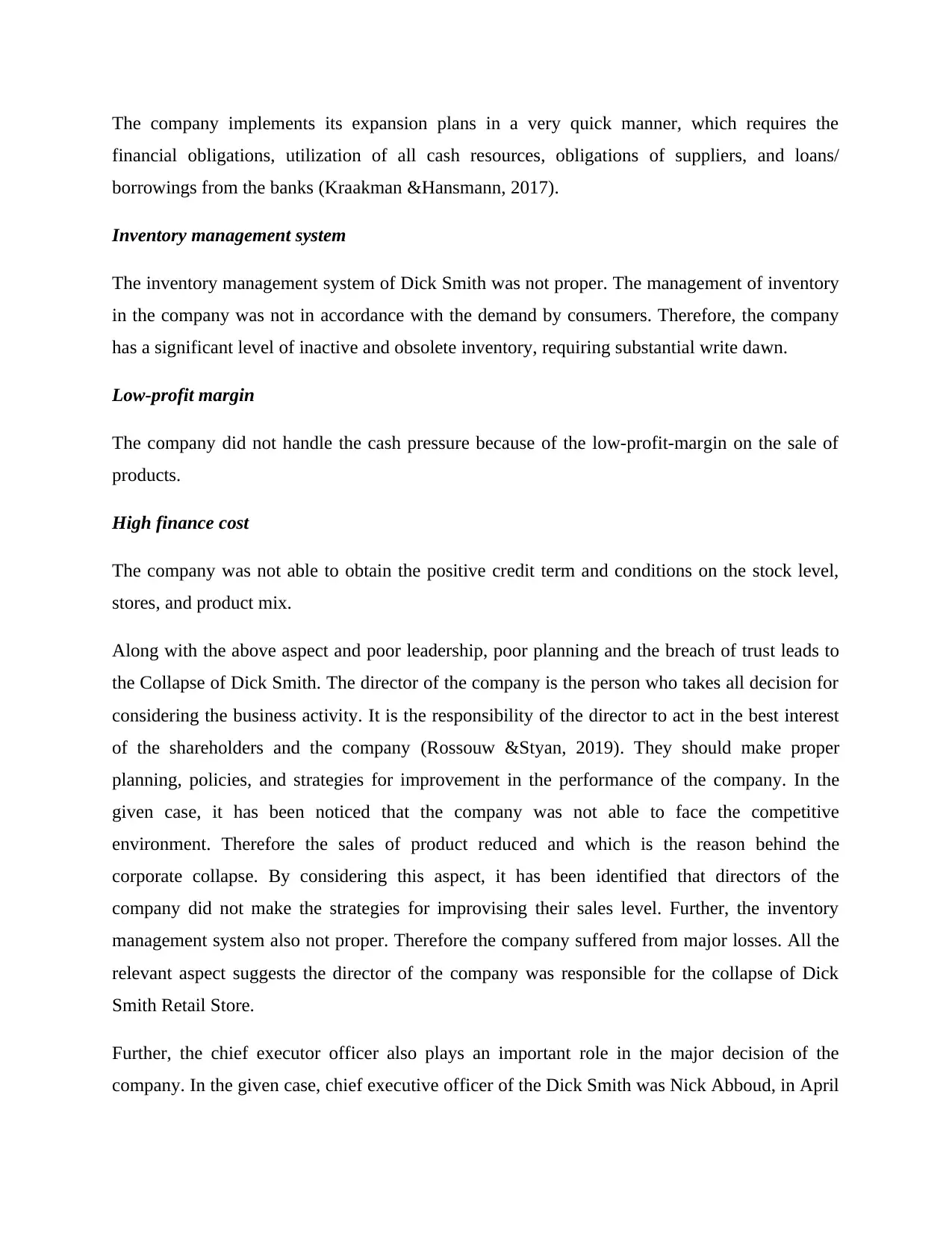
The company implements its expansion plans in a very quick manner, which requires the
financial obligations, utilization of all cash resources, obligations of suppliers, and loans/
borrowings from the banks (Kraakman &Hansmann, 2017).
Inventory management system
The inventory management system of Dick Smith was not proper. The management of inventory
in the company was not in accordance with the demand by consumers. Therefore, the company
has a significant level of inactive and obsolete inventory, requiring substantial write dawn.
Low-profit margin
The company did not handle the cash pressure because of the low-profit-margin on the sale of
products.
High finance cost
The company was not able to obtain the positive credit term and conditions on the stock level,
stores, and product mix.
Along with the above aspect and poor leadership, poor planning and the breach of trust leads to
the Collapse of Dick Smith. The director of the company is the person who takes all decision for
considering the business activity. It is the responsibility of the director to act in the best interest
of the shareholders and the company (Rossouw &Styan, 2019). They should make proper
planning, policies, and strategies for improvement in the performance of the company. In the
given case, it has been noticed that the company was not able to face the competitive
environment. Therefore the sales of product reduced and which is the reason behind the
corporate collapse. By considering this aspect, it has been identified that directors of the
company did not make the strategies for improvising their sales level. Further, the inventory
management system also not proper. Therefore the company suffered from major losses. All the
relevant aspect suggests the director of the company was responsible for the collapse of Dick
Smith Retail Store.
Further, the chief executor officer also plays an important role in the major decision of the
company. In the given case, chief executive officer of the Dick Smith was Nick Abboud, in April
financial obligations, utilization of all cash resources, obligations of suppliers, and loans/
borrowings from the banks (Kraakman &Hansmann, 2017).
Inventory management system
The inventory management system of Dick Smith was not proper. The management of inventory
in the company was not in accordance with the demand by consumers. Therefore, the company
has a significant level of inactive and obsolete inventory, requiring substantial write dawn.
Low-profit margin
The company did not handle the cash pressure because of the low-profit-margin on the sale of
products.
High finance cost
The company was not able to obtain the positive credit term and conditions on the stock level,
stores, and product mix.
Along with the above aspect and poor leadership, poor planning and the breach of trust leads to
the Collapse of Dick Smith. The director of the company is the person who takes all decision for
considering the business activity. It is the responsibility of the director to act in the best interest
of the shareholders and the company (Rossouw &Styan, 2019). They should make proper
planning, policies, and strategies for improvement in the performance of the company. In the
given case, it has been noticed that the company was not able to face the competitive
environment. Therefore the sales of product reduced and which is the reason behind the
corporate collapse. By considering this aspect, it has been identified that directors of the
company did not make the strategies for improvising their sales level. Further, the inventory
management system also not proper. Therefore the company suffered from major losses. All the
relevant aspect suggests the director of the company was responsible for the collapse of Dick
Smith Retail Store.
Further, the chief executor officer also plays an important role in the major decision of the
company. In the given case, chief executive officer of the Dick Smith was Nick Abboud, in April
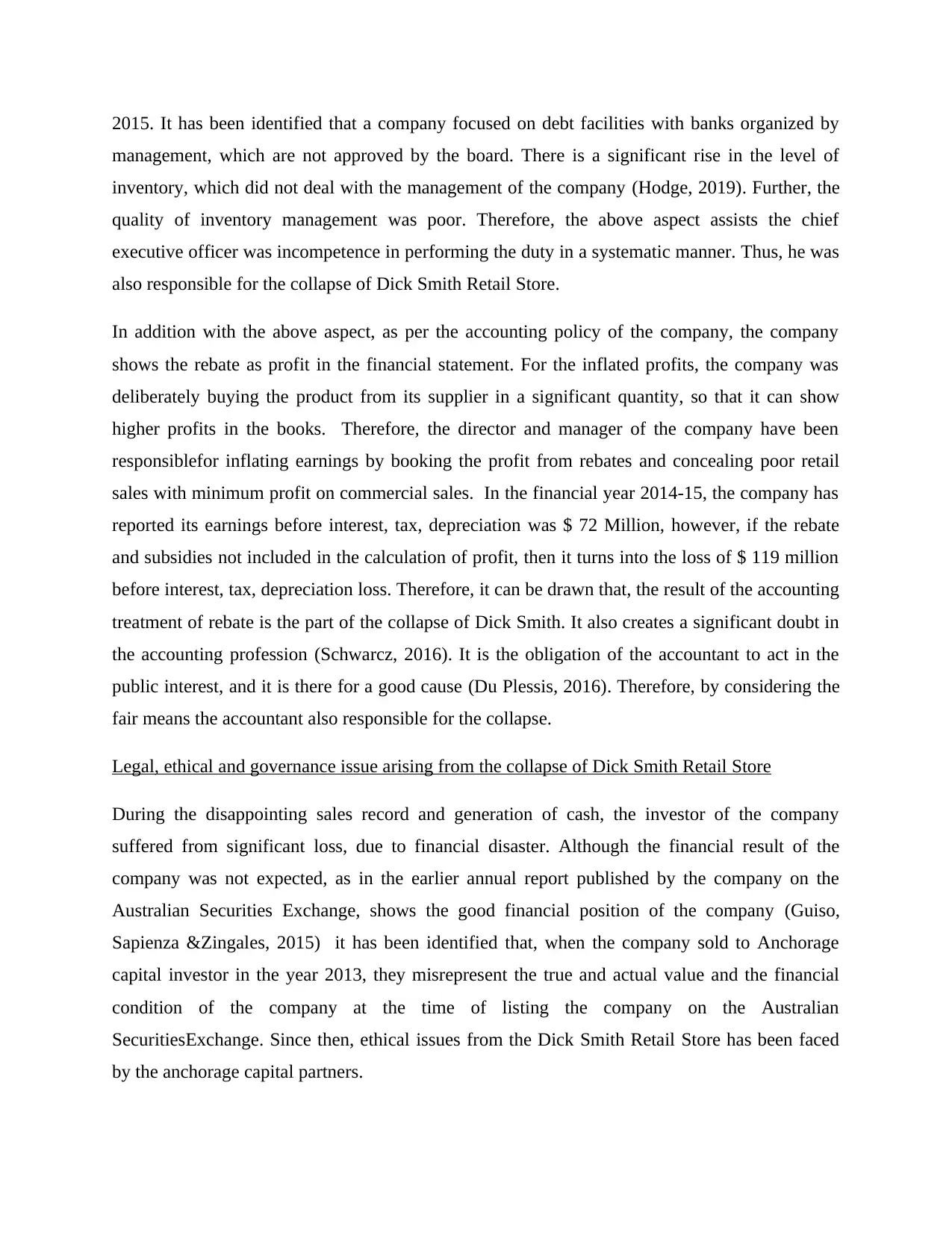
2015. It has been identified that a company focused on debt facilities with banks organized by
management, which are not approved by the board. There is a significant rise in the level of
inventory, which did not deal with the management of the company (Hodge, 2019). Further, the
quality of inventory management was poor. Therefore, the above aspect assists the chief
executive officer was incompetence in performing the duty in a systematic manner. Thus, he was
also responsible for the collapse of Dick Smith Retail Store.
In addition with the above aspect, as per the accounting policy of the company, the company
shows the rebate as profit in the financial statement. For the inflated profits, the company was
deliberately buying the product from its supplier in a significant quantity, so that it can show
higher profits in the books. Therefore, the director and manager of the company have been
responsiblefor inflating earnings by booking the profit from rebates and concealing poor retail
sales with minimum profit on commercial sales. In the financial year 2014-15, the company has
reported its earnings before interest, tax, depreciation was $ 72 Million, however, if the rebate
and subsidies not included in the calculation of profit, then it turns into the loss of $ 119 million
before interest, tax, depreciation loss. Therefore, it can be drawn that, the result of the accounting
treatment of rebate is the part of the collapse of Dick Smith. It also creates a significant doubt in
the accounting profession (Schwarcz, 2016). It is the obligation of the accountant to act in the
public interest, and it is there for a good cause (Du Plessis, 2016). Therefore, by considering the
fair means the accountant also responsible for the collapse.
Legal, ethical and governance issue arising from the collapse of Dick Smith Retail Store
During the disappointing sales record and generation of cash, the investor of the company
suffered from significant loss, due to financial disaster. Although the financial result of the
company was not expected, as in the earlier annual report published by the company on the
Australian Securities Exchange, shows the good financial position of the company (Guiso,
Sapienza &Zingales, 2015) it has been identified that, when the company sold to Anchorage
capital investor in the year 2013, they misrepresent the true and actual value and the financial
condition of the company at the time of listing the company on the Australian
SecuritiesExchange. Since then, ethical issues from the Dick Smith Retail Store has been faced
by the anchorage capital partners.
management, which are not approved by the board. There is a significant rise in the level of
inventory, which did not deal with the management of the company (Hodge, 2019). Further, the
quality of inventory management was poor. Therefore, the above aspect assists the chief
executive officer was incompetence in performing the duty in a systematic manner. Thus, he was
also responsible for the collapse of Dick Smith Retail Store.
In addition with the above aspect, as per the accounting policy of the company, the company
shows the rebate as profit in the financial statement. For the inflated profits, the company was
deliberately buying the product from its supplier in a significant quantity, so that it can show
higher profits in the books. Therefore, the director and manager of the company have been
responsiblefor inflating earnings by booking the profit from rebates and concealing poor retail
sales with minimum profit on commercial sales. In the financial year 2014-15, the company has
reported its earnings before interest, tax, depreciation was $ 72 Million, however, if the rebate
and subsidies not included in the calculation of profit, then it turns into the loss of $ 119 million
before interest, tax, depreciation loss. Therefore, it can be drawn that, the result of the accounting
treatment of rebate is the part of the collapse of Dick Smith. It also creates a significant doubt in
the accounting profession (Schwarcz, 2016). It is the obligation of the accountant to act in the
public interest, and it is there for a good cause (Du Plessis, 2016). Therefore, by considering the
fair means the accountant also responsible for the collapse.
Legal, ethical and governance issue arising from the collapse of Dick Smith Retail Store
During the disappointing sales record and generation of cash, the investor of the company
suffered from significant loss, due to financial disaster. Although the financial result of the
company was not expected, as in the earlier annual report published by the company on the
Australian Securities Exchange, shows the good financial position of the company (Guiso,
Sapienza &Zingales, 2015) it has been identified that, when the company sold to Anchorage
capital investor in the year 2013, they misrepresent the true and actual value and the financial
condition of the company at the time of listing the company on the Australian
SecuritiesExchange. Since then, ethical issues from the Dick Smith Retail Store has been faced
by the anchorage capital partners.
⊘ This is a preview!⊘
Do you want full access?
Subscribe today to unlock all pages.

Trusted by 1+ million students worldwide
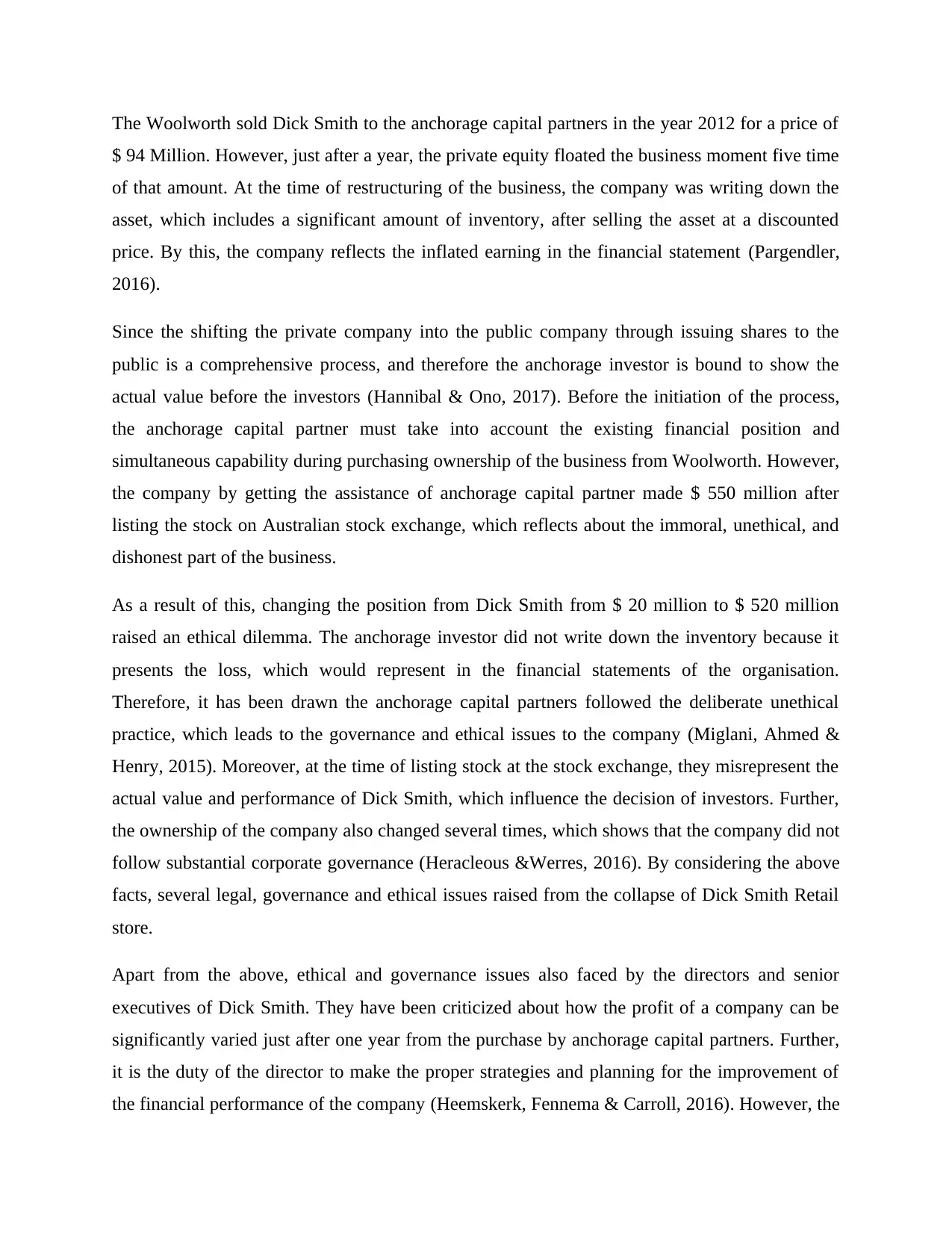
The Woolworth sold Dick Smith to the anchorage capital partners in the year 2012 for a price of
$ 94 Million. However, just after a year, the private equity floated the business moment five time
of that amount. At the time of restructuring of the business, the company was writing down the
asset, which includes a significant amount of inventory, after selling the asset at a discounted
price. By this, the company reflects the inflated earning in the financial statement (Pargendler,
2016).
Since the shifting the private company into the public company through issuing shares to the
public is a comprehensive process, and therefore the anchorage investor is bound to show the
actual value before the investors (Hannibal & Ono, 2017). Before the initiation of the process,
the anchorage capital partner must take into account the existing financial position and
simultaneous capability during purchasing ownership of the business from Woolworth. However,
the company by getting the assistance of anchorage capital partner made $ 550 million after
listing the stock on Australian stock exchange, which reflects about the immoral, unethical, and
dishonest part of the business.
As a result of this, changing the position from Dick Smith from $ 20 million to $ 520 million
raised an ethical dilemma. The anchorage investor did not write down the inventory because it
presents the loss, which would represent in the financial statements of the organisation.
Therefore, it has been drawn the anchorage capital partners followed the deliberate unethical
practice, which leads to the governance and ethical issues to the company (Miglani, Ahmed &
Henry, 2015). Moreover, at the time of listing stock at the stock exchange, they misrepresent the
actual value and performance of Dick Smith, which influence the decision of investors. Further,
the ownership of the company also changed several times, which shows that the company did not
follow substantial corporate governance (Heracleous &Werres, 2016). By considering the above
facts, several legal, governance and ethical issues raised from the collapse of Dick Smith Retail
store.
Apart from the above, ethical and governance issues also faced by the directors and senior
executives of Dick Smith. They have been criticized about how the profit of a company can be
significantly varied just after one year from the purchase by anchorage capital partners. Further,
it is the duty of the director to make the proper strategies and planning for the improvement of
the financial performance of the company (Heemskerk, Fennema & Carroll, 2016). However, the
$ 94 Million. However, just after a year, the private equity floated the business moment five time
of that amount. At the time of restructuring of the business, the company was writing down the
asset, which includes a significant amount of inventory, after selling the asset at a discounted
price. By this, the company reflects the inflated earning in the financial statement (Pargendler,
2016).
Since the shifting the private company into the public company through issuing shares to the
public is a comprehensive process, and therefore the anchorage investor is bound to show the
actual value before the investors (Hannibal & Ono, 2017). Before the initiation of the process,
the anchorage capital partner must take into account the existing financial position and
simultaneous capability during purchasing ownership of the business from Woolworth. However,
the company by getting the assistance of anchorage capital partner made $ 550 million after
listing the stock on Australian stock exchange, which reflects about the immoral, unethical, and
dishonest part of the business.
As a result of this, changing the position from Dick Smith from $ 20 million to $ 520 million
raised an ethical dilemma. The anchorage investor did not write down the inventory because it
presents the loss, which would represent in the financial statements of the organisation.
Therefore, it has been drawn the anchorage capital partners followed the deliberate unethical
practice, which leads to the governance and ethical issues to the company (Miglani, Ahmed &
Henry, 2015). Moreover, at the time of listing stock at the stock exchange, they misrepresent the
actual value and performance of Dick Smith, which influence the decision of investors. Further,
the ownership of the company also changed several times, which shows that the company did not
follow substantial corporate governance (Heracleous &Werres, 2016). By considering the above
facts, several legal, governance and ethical issues raised from the collapse of Dick Smith Retail
store.
Apart from the above, ethical and governance issues also faced by the directors and senior
executives of Dick Smith. They have been criticized about how the profit of a company can be
significantly varied just after one year from the purchase by anchorage capital partners. Further,
it is the duty of the director to make the proper strategies and planning for the improvement of
the financial performance of the company (Heemskerk, Fennema & Carroll, 2016). However, the
Paraphrase This Document
Need a fresh take? Get an instant paraphrase of this document with our AI Paraphraser
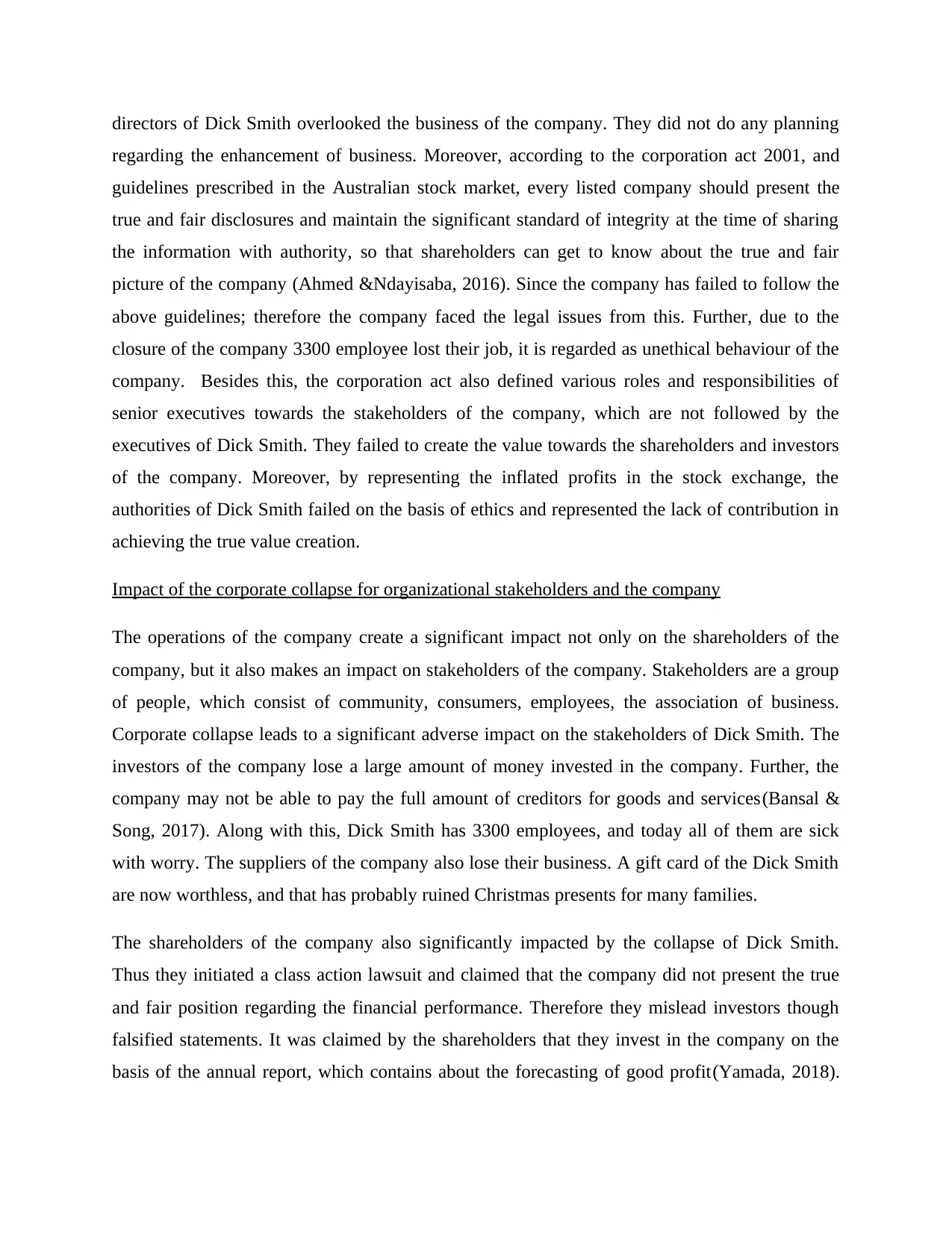
directors of Dick Smith overlooked the business of the company. They did not do any planning
regarding the enhancement of business. Moreover, according to the corporation act 2001, and
guidelines prescribed in the Australian stock market, every listed company should present the
true and fair disclosures and maintain the significant standard of integrity at the time of sharing
the information with authority, so that shareholders can get to know about the true and fair
picture of the company (Ahmed &Ndayisaba, 2016). Since the company has failed to follow the
above guidelines; therefore the company faced the legal issues from this. Further, due to the
closure of the company 3300 employee lost their job, it is regarded as unethical behaviour of the
company. Besides this, the corporation act also defined various roles and responsibilities of
senior executives towards the stakeholders of the company, which are not followed by the
executives of Dick Smith. They failed to create the value towards the shareholders and investors
of the company. Moreover, by representing the inflated profits in the stock exchange, the
authorities of Dick Smith failed on the basis of ethics and represented the lack of contribution in
achieving the true value creation.
Impact of the corporate collapse for organizational stakeholders and the company
The operations of the company create a significant impact not only on the shareholders of the
company, but it also makes an impact on stakeholders of the company. Stakeholders are a group
of people, which consist of community, consumers, employees, the association of business.
Corporate collapse leads to a significant adverse impact on the stakeholders of Dick Smith. The
investors of the company lose a large amount of money invested in the company. Further, the
company may not be able to pay the full amount of creditors for goods and services(Bansal &
Song, 2017). Along with this, Dick Smith has 3300 employees, and today all of them are sick
with worry. The suppliers of the company also lose their business. A gift card of the Dick Smith
are now worthless, and that has probably ruined Christmas presents for many families.
The shareholders of the company also significantly impacted by the collapse of Dick Smith.
Thus they initiated a class action lawsuit and claimed that the company did not present the true
and fair position regarding the financial performance. Therefore they mislead investors though
falsified statements. It was claimed by the shareholders that they invest in the company on the
basis of the annual report, which contains about the forecasting of good profit(Yamada, 2018).
regarding the enhancement of business. Moreover, according to the corporation act 2001, and
guidelines prescribed in the Australian stock market, every listed company should present the
true and fair disclosures and maintain the significant standard of integrity at the time of sharing
the information with authority, so that shareholders can get to know about the true and fair
picture of the company (Ahmed &Ndayisaba, 2016). Since the company has failed to follow the
above guidelines; therefore the company faced the legal issues from this. Further, due to the
closure of the company 3300 employee lost their job, it is regarded as unethical behaviour of the
company. Besides this, the corporation act also defined various roles and responsibilities of
senior executives towards the stakeholders of the company, which are not followed by the
executives of Dick Smith. They failed to create the value towards the shareholders and investors
of the company. Moreover, by representing the inflated profits in the stock exchange, the
authorities of Dick Smith failed on the basis of ethics and represented the lack of contribution in
achieving the true value creation.
Impact of the corporate collapse for organizational stakeholders and the company
The operations of the company create a significant impact not only on the shareholders of the
company, but it also makes an impact on stakeholders of the company. Stakeholders are a group
of people, which consist of community, consumers, employees, the association of business.
Corporate collapse leads to a significant adverse impact on the stakeholders of Dick Smith. The
investors of the company lose a large amount of money invested in the company. Further, the
company may not be able to pay the full amount of creditors for goods and services(Bansal &
Song, 2017). Along with this, Dick Smith has 3300 employees, and today all of them are sick
with worry. The suppliers of the company also lose their business. A gift card of the Dick Smith
are now worthless, and that has probably ruined Christmas presents for many families.
The shareholders of the company also significantly impacted by the collapse of Dick Smith.
Thus they initiated a class action lawsuit and claimed that the company did not present the true
and fair position regarding the financial performance. Therefore they mislead investors though
falsified statements. It was claimed by the shareholders that they invest in the company on the
basis of the annual report, which contains about the forecasting of good profit(Yamada, 2018).
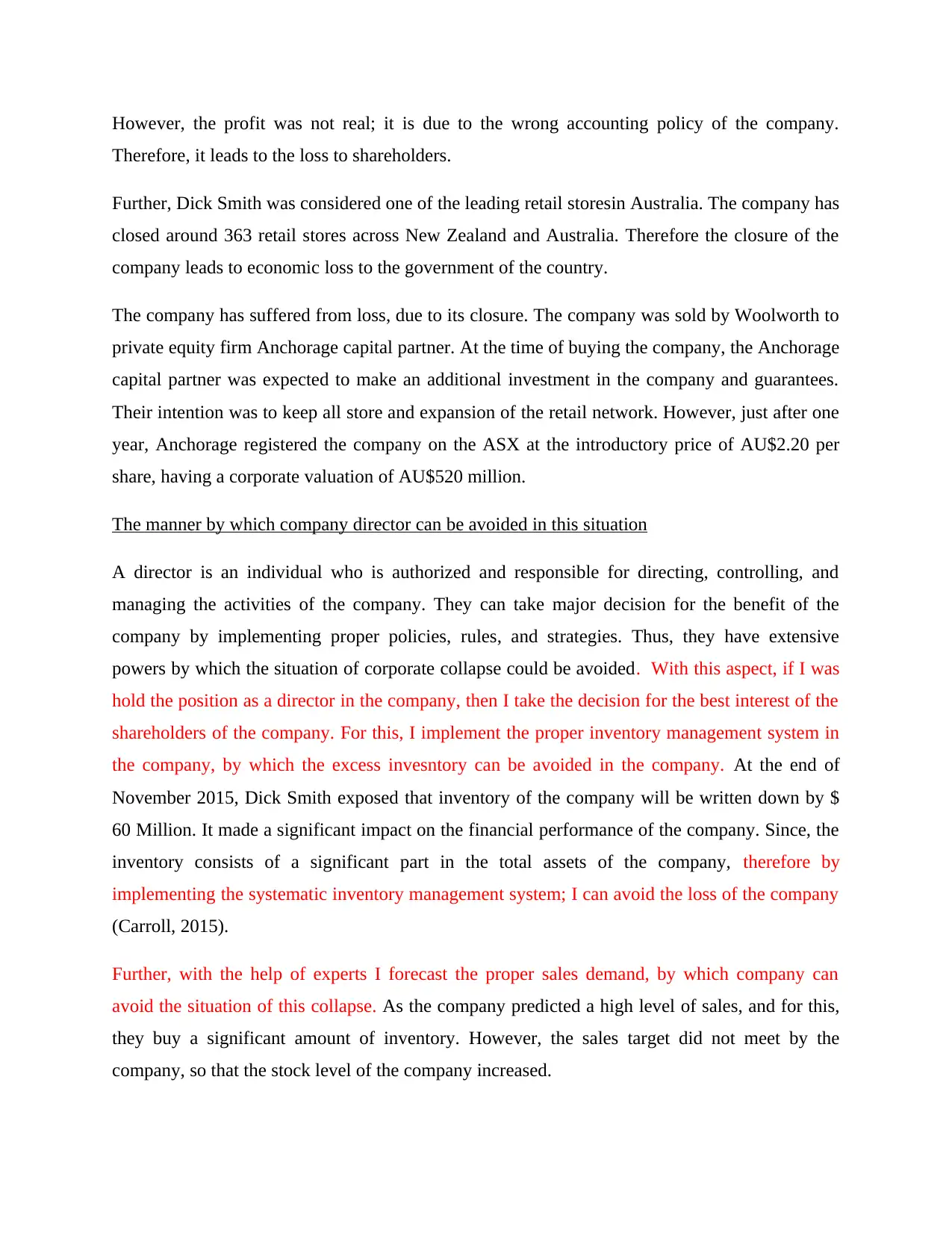
However, the profit was not real; it is due to the wrong accounting policy of the company.
Therefore, it leads to the loss to shareholders.
Further, Dick Smith was considered one of the leading retail storesin Australia. The company has
closed around 363 retail stores across New Zealand and Australia. Therefore the closure of the
company leads to economic loss to the government of the country.
The company has suffered from loss, due to its closure. The company was sold by Woolworth to
private equity firm Anchorage capital partner. At the time of buying the company, the Anchorage
capital partner was expected to make an additional investment in the company and guarantees.
Their intention was to keep all store and expansion of the retail network. However, just after one
year, Anchorage registered the company on the ASX at the introductory price of AU$2.20 per
share, having a corporate valuation of AU$520 million.
The manner by which company director can be avoided in this situation
A director is an individual who is authorized and responsible for directing, controlling, and
managing the activities of the company. They can take major decision for the benefit of the
company by implementing proper policies, rules, and strategies. Thus, they have extensive
powers by which the situation of corporate collapse could be avoided. With this aspect, if I was
hold the position as a director in the company, then I take the decision for the best interest of the
shareholders of the company. For this, I implement the proper inventory management system in
the company, by which the excess invesntory can be avoided in the company. At the end of
November 2015, Dick Smith exposed that inventory of the company will be written down by $
60 Million. It made a significant impact on the financial performance of the company. Since, the
inventory consists of a significant part in the total assets of the company, therefore by
implementing the systematic inventory management system; I can avoid the loss of the company
(Carroll, 2015).
Further, with the help of experts I forecast the proper sales demand, by which company can
avoid the situation of this collapse. As the company predicted a high level of sales, and for this,
they buy a significant amount of inventory. However, the sales target did not meet by the
company, so that the stock level of the company increased.
Therefore, it leads to the loss to shareholders.
Further, Dick Smith was considered one of the leading retail storesin Australia. The company has
closed around 363 retail stores across New Zealand and Australia. Therefore the closure of the
company leads to economic loss to the government of the country.
The company has suffered from loss, due to its closure. The company was sold by Woolworth to
private equity firm Anchorage capital partner. At the time of buying the company, the Anchorage
capital partner was expected to make an additional investment in the company and guarantees.
Their intention was to keep all store and expansion of the retail network. However, just after one
year, Anchorage registered the company on the ASX at the introductory price of AU$2.20 per
share, having a corporate valuation of AU$520 million.
The manner by which company director can be avoided in this situation
A director is an individual who is authorized and responsible for directing, controlling, and
managing the activities of the company. They can take major decision for the benefit of the
company by implementing proper policies, rules, and strategies. Thus, they have extensive
powers by which the situation of corporate collapse could be avoided. With this aspect, if I was
hold the position as a director in the company, then I take the decision for the best interest of the
shareholders of the company. For this, I implement the proper inventory management system in
the company, by which the excess invesntory can be avoided in the company. At the end of
November 2015, Dick Smith exposed that inventory of the company will be written down by $
60 Million. It made a significant impact on the financial performance of the company. Since, the
inventory consists of a significant part in the total assets of the company, therefore by
implementing the systematic inventory management system; I can avoid the loss of the company
(Carroll, 2015).
Further, with the help of experts I forecast the proper sales demand, by which company can
avoid the situation of this collapse. As the company predicted a high level of sales, and for this,
they buy a significant amount of inventory. However, the sales target did not meet by the
company, so that the stock level of the company increased.
⊘ This is a preview!⊘
Do you want full access?
Subscribe today to unlock all pages.

Trusted by 1+ million students worldwide
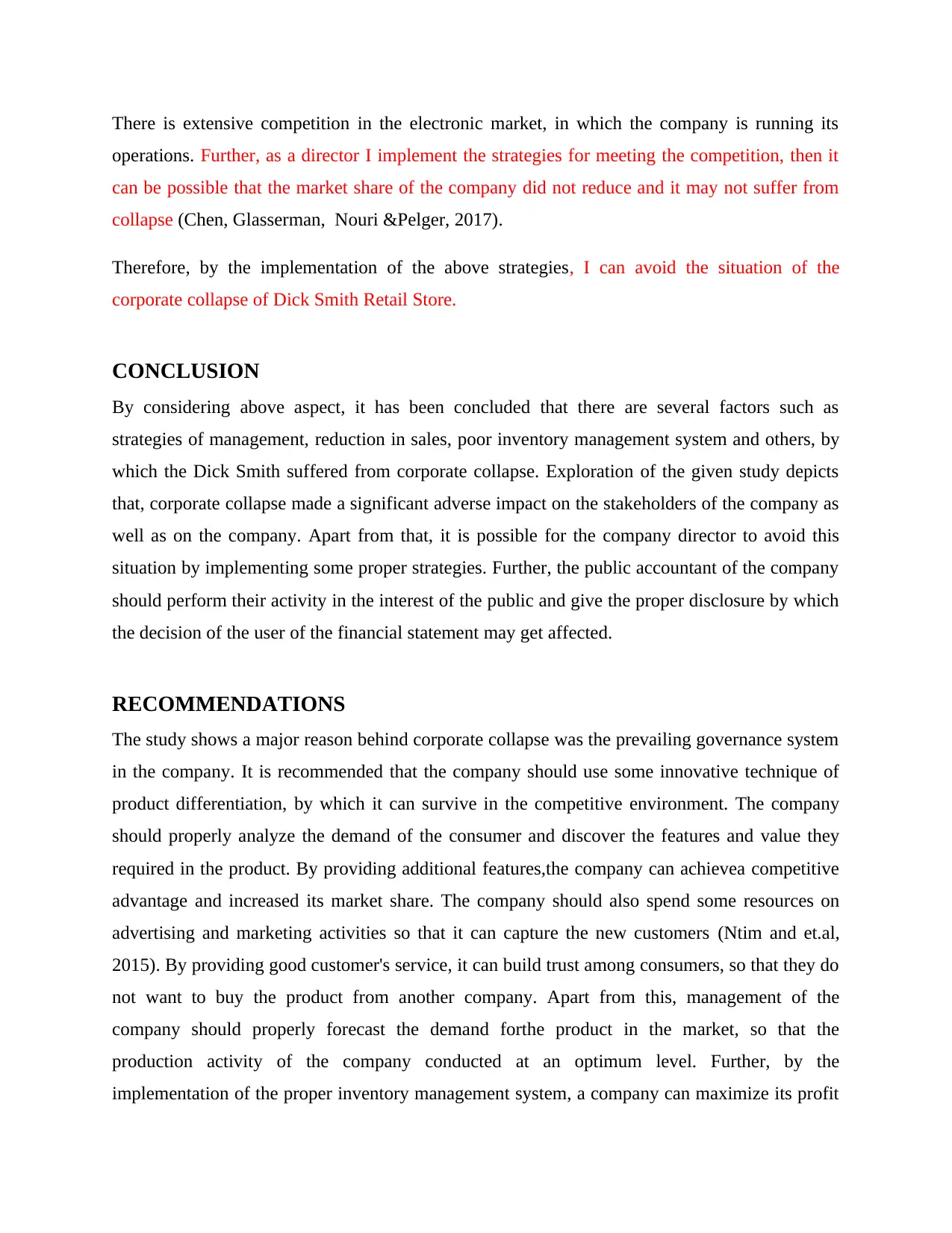
There is extensive competition in the electronic market, in which the company is running its
operations. Further, as a director I implement the strategies for meeting the competition, then it
can be possible that the market share of the company did not reduce and it may not suffer from
collapse (Chen, Glasserman, Nouri &Pelger, 2017).
Therefore, by the implementation of the above strategies, I can avoid the situation of the
corporate collapse of Dick Smith Retail Store.
CONCLUSION
By considering above aspect, it has been concluded that there are several factors such as
strategies of management, reduction in sales, poor inventory management system and others, by
which the Dick Smith suffered from corporate collapse. Exploration of the given study depicts
that, corporate collapse made a significant adverse impact on the stakeholders of the company as
well as on the company. Apart from that, it is possible for the company director to avoid this
situation by implementing some proper strategies. Further, the public accountant of the company
should perform their activity in the interest of the public and give the proper disclosure by which
the decision of the user of the financial statement may get affected.
RECOMMENDATIONS
The study shows a major reason behind corporate collapse was the prevailing governance system
in the company. It is recommended that the company should use some innovative technique of
product differentiation, by which it can survive in the competitive environment. The company
should properly analyze the demand of the consumer and discover the features and value they
required in the product. By providing additional features,the company can achievea competitive
advantage and increased its market share. The company should also spend some resources on
advertising and marketing activities so that it can capture the new customers (Ntim and et.al,
2015). By providing good customer's service, it can build trust among consumers, so that they do
not want to buy the product from another company. Apart from this, management of the
company should properly forecast the demand forthe product in the market, so that the
production activity of the company conducted at an optimum level. Further, by the
implementation of the proper inventory management system, a company can maximize its profit
operations. Further, as a director I implement the strategies for meeting the competition, then it
can be possible that the market share of the company did not reduce and it may not suffer from
collapse (Chen, Glasserman, Nouri &Pelger, 2017).
Therefore, by the implementation of the above strategies, I can avoid the situation of the
corporate collapse of Dick Smith Retail Store.
CONCLUSION
By considering above aspect, it has been concluded that there are several factors such as
strategies of management, reduction in sales, poor inventory management system and others, by
which the Dick Smith suffered from corporate collapse. Exploration of the given study depicts
that, corporate collapse made a significant adverse impact on the stakeholders of the company as
well as on the company. Apart from that, it is possible for the company director to avoid this
situation by implementing some proper strategies. Further, the public accountant of the company
should perform their activity in the interest of the public and give the proper disclosure by which
the decision of the user of the financial statement may get affected.
RECOMMENDATIONS
The study shows a major reason behind corporate collapse was the prevailing governance system
in the company. It is recommended that the company should use some innovative technique of
product differentiation, by which it can survive in the competitive environment. The company
should properly analyze the demand of the consumer and discover the features and value they
required in the product. By providing additional features,the company can achievea competitive
advantage and increased its market share. The company should also spend some resources on
advertising and marketing activities so that it can capture the new customers (Ntim and et.al,
2015). By providing good customer's service, it can build trust among consumers, so that they do
not want to buy the product from another company. Apart from this, management of the
company should properly forecast the demand forthe product in the market, so that the
production activity of the company conducted at an optimum level. Further, by the
implementation of the proper inventory management system, a company can maximize its profit
Paraphrase This Document
Need a fresh take? Get an instant paraphrase of this document with our AI Paraphraser
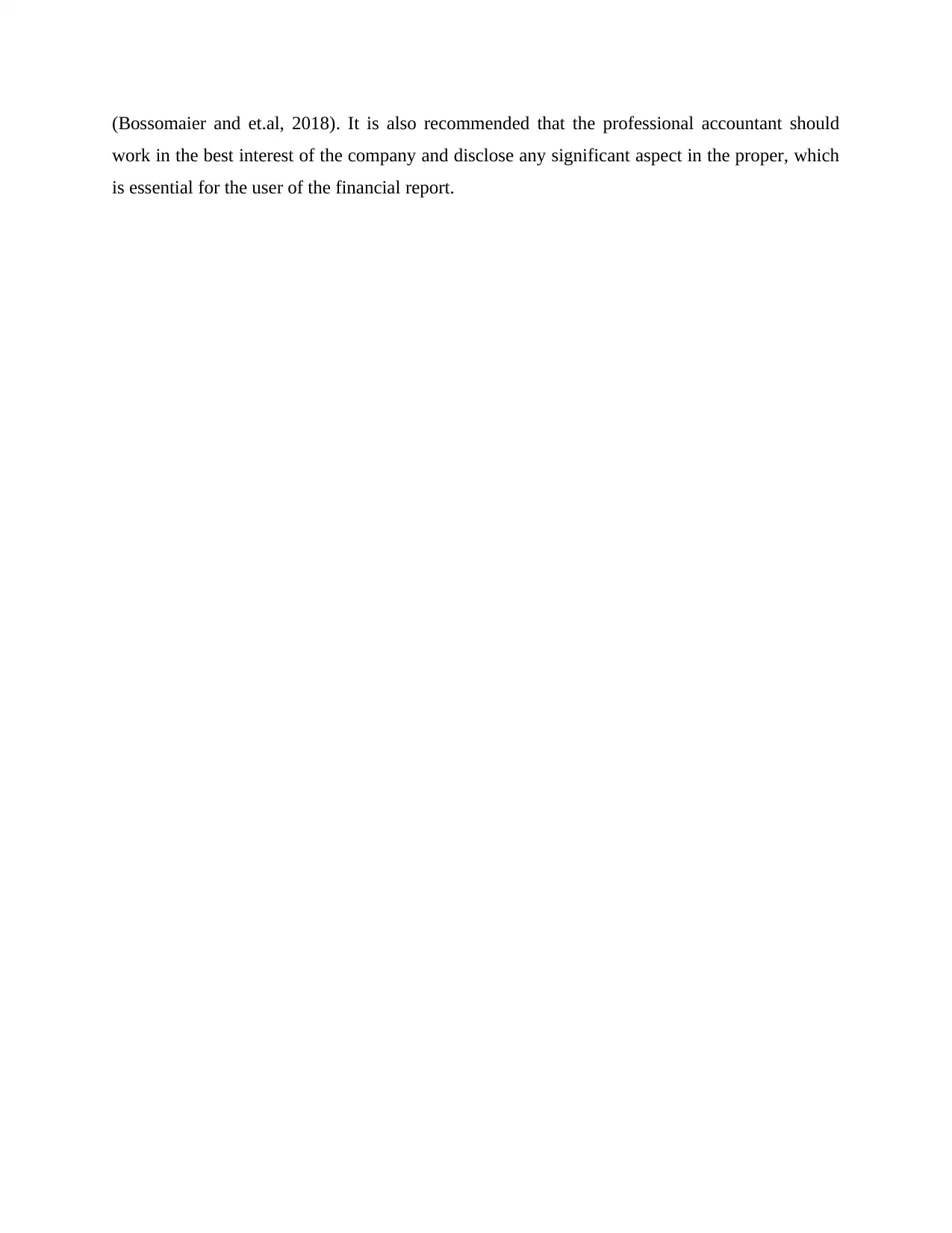
(Bossomaier and et.al, 2018). It is also recommended that the professional accountant should
work in the best interest of the company and disclose any significant aspect in the proper, which
is essential for the user of the financial report.
work in the best interest of the company and disclose any significant aspect in the proper, which
is essential for the user of the financial report.
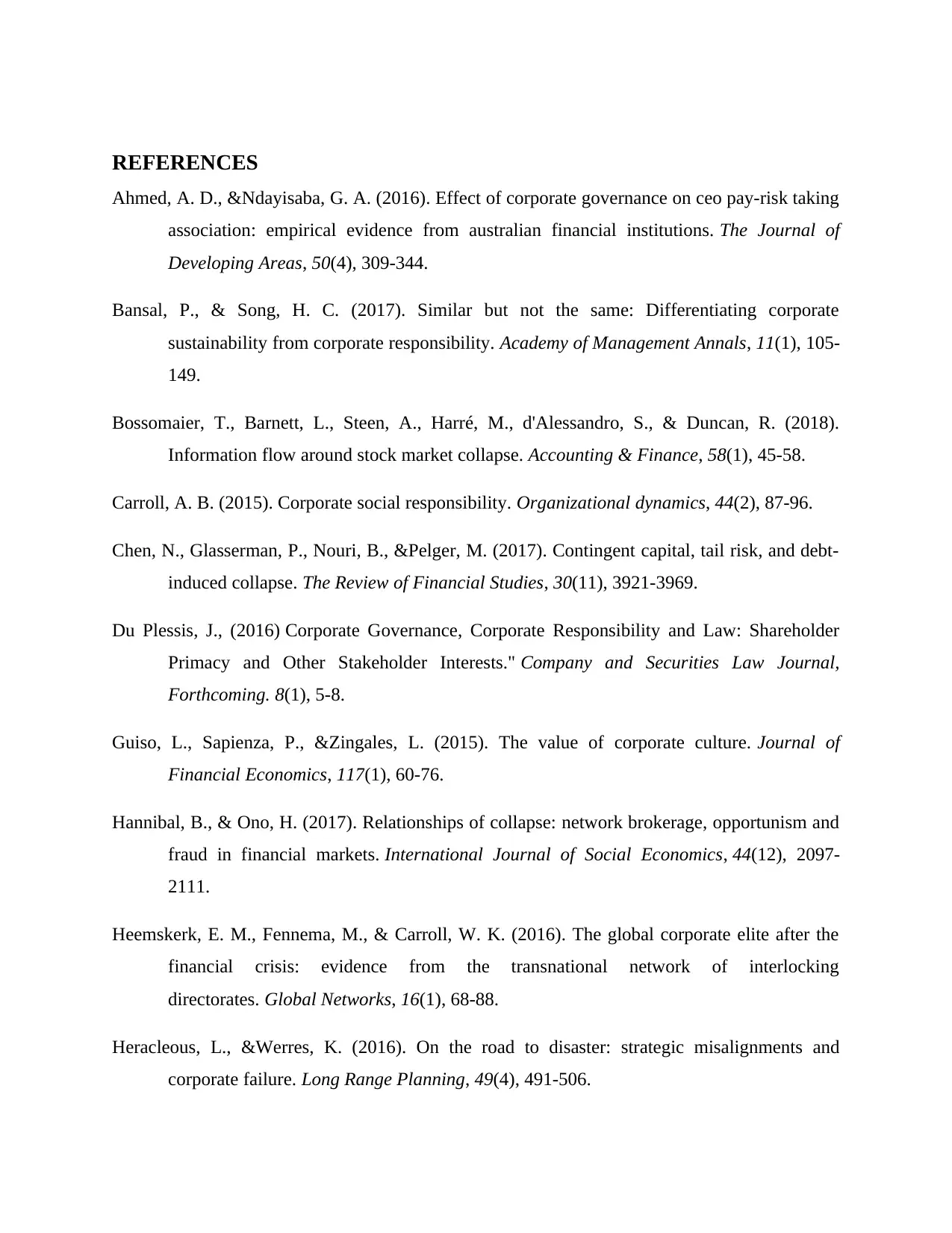
REFERENCES
Ahmed, A. D., &Ndayisaba, G. A. (2016). Effect of corporate governance on ceo pay-risk taking
association: empirical evidence from australian financial institutions. The Journal of
Developing Areas, 50(4), 309-344.
Bansal, P., & Song, H. C. (2017). Similar but not the same: Differentiating corporate
sustainability from corporate responsibility. Academy of Management Annals, 11(1), 105-
149.
Bossomaier, T., Barnett, L., Steen, A., Harré, M., d'Alessandro, S., & Duncan, R. (2018).
Information flow around stock market collapse. Accounting & Finance, 58(1), 45-58.
Carroll, A. B. (2015). Corporate social responsibility. Organizational dynamics, 44(2), 87-96.
Chen, N., Glasserman, P., Nouri, B., &Pelger, M. (2017). Contingent capital, tail risk, and debt-
induced collapse. The Review of Financial Studies, 30(11), 3921-3969.
Du Plessis, J., (2016) Corporate Governance, Corporate Responsibility and Law: Shareholder
Primacy and Other Stakeholder Interests." Company and Securities Law Journal,
Forthcoming. 8(1), 5-8.
Guiso, L., Sapienza, P., &Zingales, L. (2015). The value of corporate culture. Journal of
Financial Economics, 117(1), 60-76.
Hannibal, B., & Ono, H. (2017). Relationships of collapse: network brokerage, opportunism and
fraud in financial markets. International Journal of Social Economics, 44(12), 2097-
2111.
Heemskerk, E. M., Fennema, M., & Carroll, W. K. (2016). The global corporate elite after the
financial crisis: evidence from the transnational network of interlocking
directorates. Global Networks, 16(1), 68-88.
Heracleous, L., &Werres, K. (2016). On the road to disaster: strategic misalignments and
corporate failure. Long Range Planning, 49(4), 491-506.
Ahmed, A. D., &Ndayisaba, G. A. (2016). Effect of corporate governance on ceo pay-risk taking
association: empirical evidence from australian financial institutions. The Journal of
Developing Areas, 50(4), 309-344.
Bansal, P., & Song, H. C. (2017). Similar but not the same: Differentiating corporate
sustainability from corporate responsibility. Academy of Management Annals, 11(1), 105-
149.
Bossomaier, T., Barnett, L., Steen, A., Harré, M., d'Alessandro, S., & Duncan, R. (2018).
Information flow around stock market collapse. Accounting & Finance, 58(1), 45-58.
Carroll, A. B. (2015). Corporate social responsibility. Organizational dynamics, 44(2), 87-96.
Chen, N., Glasserman, P., Nouri, B., &Pelger, M. (2017). Contingent capital, tail risk, and debt-
induced collapse. The Review of Financial Studies, 30(11), 3921-3969.
Du Plessis, J., (2016) Corporate Governance, Corporate Responsibility and Law: Shareholder
Primacy and Other Stakeholder Interests." Company and Securities Law Journal,
Forthcoming. 8(1), 5-8.
Guiso, L., Sapienza, P., &Zingales, L. (2015). The value of corporate culture. Journal of
Financial Economics, 117(1), 60-76.
Hannibal, B., & Ono, H. (2017). Relationships of collapse: network brokerage, opportunism and
fraud in financial markets. International Journal of Social Economics, 44(12), 2097-
2111.
Heemskerk, E. M., Fennema, M., & Carroll, W. K. (2016). The global corporate elite after the
financial crisis: evidence from the transnational network of interlocking
directorates. Global Networks, 16(1), 68-88.
Heracleous, L., &Werres, K. (2016). On the road to disaster: strategic misalignments and
corporate failure. Long Range Planning, 49(4), 491-506.
⊘ This is a preview!⊘
Do you want full access?
Subscribe today to unlock all pages.

Trusted by 1+ million students worldwide
1 out of 14
Related Documents
Your All-in-One AI-Powered Toolkit for Academic Success.
+13062052269
info@desklib.com
Available 24*7 on WhatsApp / Email
![[object Object]](/_next/static/media/star-bottom.7253800d.svg)
Unlock your academic potential
Copyright © 2020–2025 A2Z Services. All Rights Reserved. Developed and managed by ZUCOL.





